| 1 | Green catsnake |
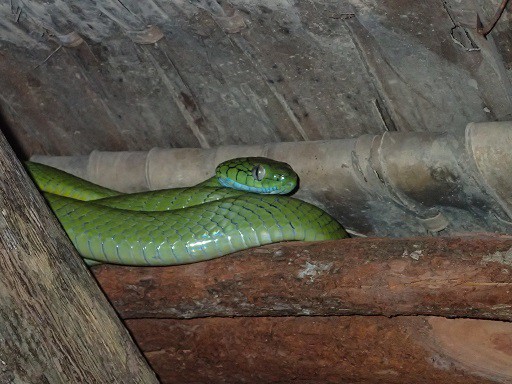
The Boiga catsnake family has 42 members, mainly found in the Indian subcontinent and southeastern Asia. Their signature characteristics are vertical slits for pupils, resting on branches for most of the day, and a rear-fanged venom traditionally viewed as mild, which nevertheless contains a smattering of neurotoxins.
The green catsnake (Boiga cyanea) is the most common of the family in Thailand, and perhaps the most common overall. They cover Vietnam, Cambodia, Myanmar, and to the northwest, they reach Bangladesh and fizzle out in northeast India. To the south, they just cross the southern Thai border into peninsular Malaysia.
Green catsnakes typically rest on branches 2-3 metres high, never exceeding 10 metres. By day, they rest immobile, while by night, they activate, and move up to 55 metres in a session. This is an energetic snake, unlike their dangerous Thai lookalike, the white-lipped pitviper. Green catsnakes are a notorious bird predator, contributing 33% of nest raidings in northeast Thailand. Their most common prey includes the oriental garden lizard, and they don’t shy away from fellow snakes like striped kukri snakes.
The green catsnake has never once killed a human, but a brief bite is capable of killing fellow snakes within 30 hours.
| 2 | Brown tree snake |
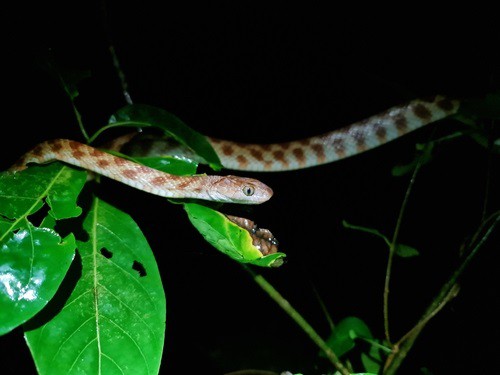
Australia’s only Boiga catsnake species. This is a notorious invasive species which landed on the US Pacific territory of Guam just after World War 2, and proceeded to decimate the island’s native bird population. Brown tree snakes also inhabit New Guinea and the Indonesian island of Sulawesi.
This species never has any traces of green or blue on its body. It’s significantly longer than the green catsnake, at an alltime record of 3 metres (recorded on Guam) versus 184cm. Its venom is typical: weak with a handful of neurotoxins. A 2006 study identified 446 bites over 18 years on Guam. No deaths occurred, and only infants under 1 year suffered systemic effects. Disturbingly, many bites happened in victims’ bedrooms. Parents walked in to find a brown tree snake coiled around their child. This species loves to slither stealthily through people’s windows.
All Boiga catsnakes are strong climbers, but the brown catsnake ascends above to become perhaps the greatest climber of all 3900 snake species. In 2021, they were discovered to use a unique “lasso” manoeuvre, coiling a small portion of their body around a metal cylinder for grip, then thrusting the next two thirds of their body upwards. This allowed them to climb a metal cylinder which scientists had placed a bird box on top of, which was so smooth that scientists believed it to be impenetrable.
| 3 | Sri Lankan catsnake |
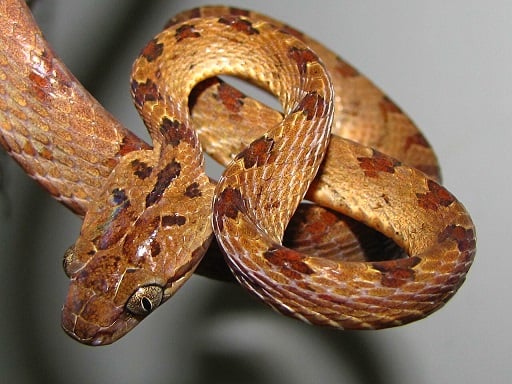
This species lives exclusively on the island nation of Sri Lanka, just southeast of India. Though superficially similar to the brown tree snake, it is overlaid with black (or chocolatey brown) bars and stripes. Sri Lankan catsnakes have a vicious disposition, and will unleash a furious storm of painful bites if gripped.
This species is relatively short, as the maximum so far measured just 120cm, though Guam has far more researchers due to being a US military base. Confirmed prey include geckos, which it often invades houses to snatch. The Sri Lankan catsnake is also a confirmed cannibal.
Despite their savage aggression, Sri Lankan catsnakes are unable to kill humans, no matter how much they scheme and plan. A 1969 report detailed a man who was bitten on the left middle finger for several minutes. His hand later swelled to levels similar to a bee sting, but subsided after two hours. He experienced no systemic symptoms. Likewise, a 2023 study detailed 7 bites from 3 Sri Lankan catsnakes, including Boiga ceylonensis. None led to systemic symptoms, just mild local symptoms. Sri Lanka catsnakes are recognisable by a consistent black streak that starts behind the eye.
| 4 | Common catsnake |
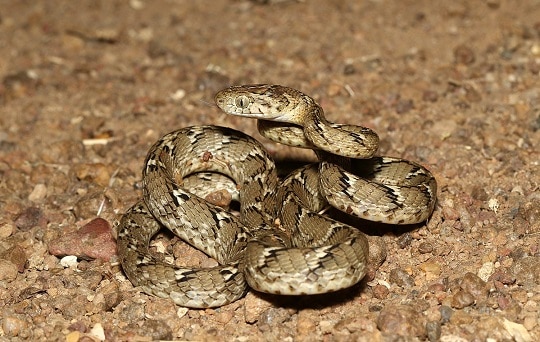
The most westerly and the most northerly of the 42 catsnake species. Common catsnakes (Boiga trigonata) are the Indian version, just as the green catsnake is the Thai version. They cover virtually the entire country, as well as Sri Lanka. To the west, they also reach Pakistan, pushing past any of their family. To the north, they’ve been sighted near Islamabad.
The common catsnake has more viperid patterns than other Boiga catsnakes, and is believed to be mimicking the Indian saw-scaled viper, gaining it a shield of protection. This is one of the most ground-dwelling catsnakes, appearing in low bushes as well as tree branches. Boiga trigonata is a confirmed meal for birds of prey like Jerdon’s baza, and fellow snakes like the infamous banded krait (Bungarus fasciatus).
Like all Boiga catsnakes, they lay eggs rather than live young, in batches of 6-12. Common catsnakes have a varied diet, but are confirmed to feed on oriental garden lizards (Calotes versicolor), like the green catsnake in Thailand. This seems to be a beloved meal of the Boiga catsnake family overall.
| 5 | Andaman catsnake |
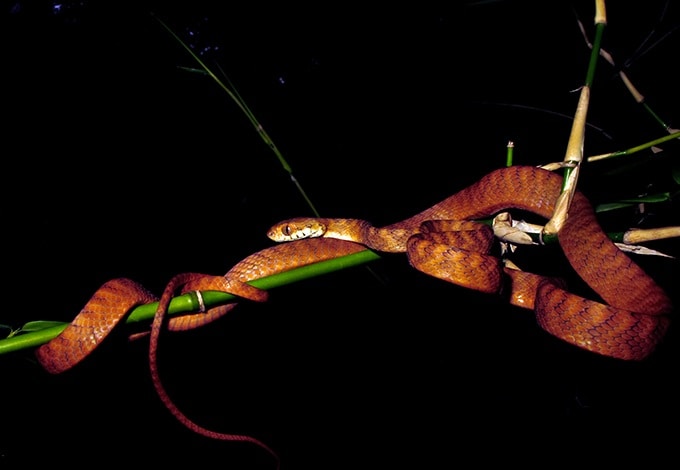
This catsnake species lives exclusively on the Andaman Islands, officially part of India, but closer to Thailand geographically. The Andaman catsnake was originally assigned as a Sri Lankan catsnake subspecies, but is now independent. This catsnake is rarely found outside of forests, particularly inhabiting tropical moist deciduous and tropical evergreen forest. They sometimes appear in the thatched roofs of houses, and are near exclusively nocturnal.
This is a species which transforms with age. At birth they’re a bright orange, even a vibrant red, which spreads to their eyes. In adulthood, they blossom into a dull olive-green, like a reverse butterfly.
The Andaman catsnake is mid-length for its family, at an all time record of 167cm. Andaman catsnakes move slowly and patiently, prowling around their forests with no need to rush. But if flustered, they’ll suddenly fly into an elaborate display of aggression, with their body coiled into an S, their tail wiggling, and unleashing multiple mock strikes. Andaman catsnakes are rear-fanged like other Boiga members, but nothing is known about venom’s chemical makeup or potency. Their diet consists of lizards and geckos.
| 6 | Philippine catsnake |
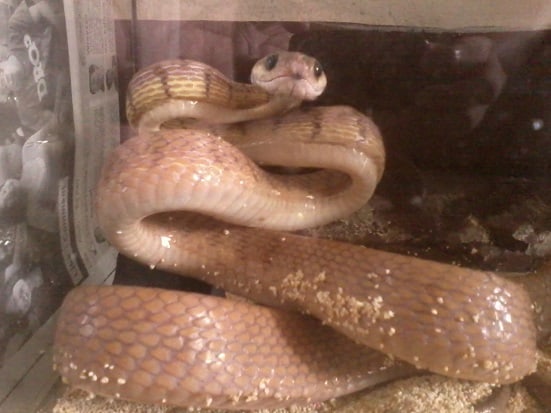
This species has no overlap with brown tree snakes or green catsnakes, because it lives exclusively in the Philippines. Philippine catsnakes (Boiga philippina) can reach a relatively long 213cm, and supposedly have a stronger venom than other members, though research is severely lacking.
This snake makes a loud puffing noise before unleashing its strike, usually from its tree branch. Philippine catsnakes have a tendency to show up in trees near chicken coops, having just returned from a ground mission to snatch the eggs.
Philippine catsnakes have some of the least obvious patterns. From a distance, they’re a plain colour, usually orange or light brown. Thin, faint bars appear when you get closer, but no complex viperid patterns like the Indian catsnake. Another catsnake of the Philippines is Boiga angulata, the Leyte cat snake, and this has far more complex patterns, making the two easy to distinguish.
This species is an expert at coiling its long body sinuously around stalks and branches, to avoid a hard plummet to the ground. It does this instinctively, with no need for conscious thought (not like it’s capable of thinking anyway).
| 7 | Nicobar catsnake |
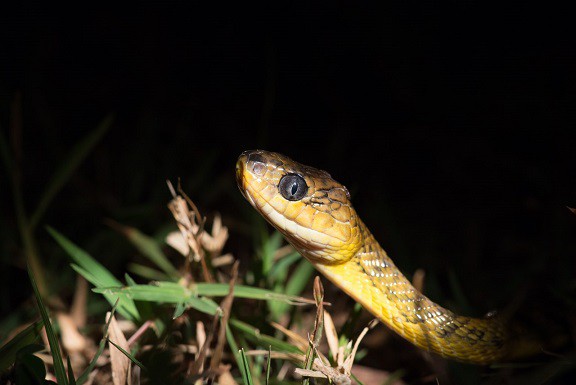
This species is endemic just to three islands: Great Nicobar, Little Nicobar and Pilo Milo Island. The Nicobar catsnake (Boiga wallachi) reaches a maximum of 1.4 metres.
This snake is poorly researched, and we mostly have anecdotal reports from locals to rely on. According to this scribe, the Nicobar catsnake is highly terrestrial (ground-dwelling), and perhaps one of the least reliant on branches. Many were found on the forest floor by small forest steams, hunting for frogs. Amphibians are also a rare diet for Boiga catsnakes, which rely primarily on reptiles and birds. They tend to appear alongside triangle keelbacks, and rumours suggest its venom is unusually strong. One local man reported a swollen leg persisting for 2 days. Another blamed the Nicobar catsnake for his amputated thumb. The venom’s chemical composition hasn’t been analysed yet.
Nicobar catsnakes hunt birds as well, as they stealthily invade chicken coops. This is a mainly yellow catsnake, but adorned with subtle black markings on each scale.
| 8 | Thackeray’s catsnake |
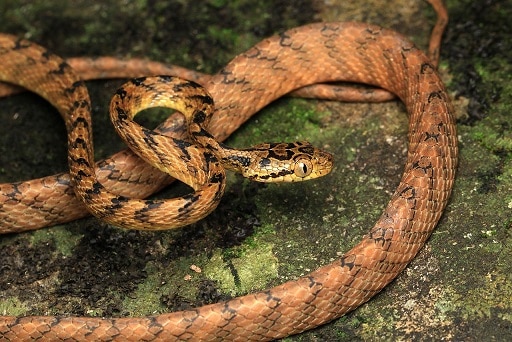
This Boiga catsnake lives in one specific region of India; the western Ghats mountain range, a damp range of forested hills in the southwest which is officially a Unesco World Heritage site, on account of being a biodiversity haven.
Thackery’s catsnake was discovered in 2019, and has one of the weirdest diets. It feeds on frog eggs, specifically those of the Bombay night frog (Nyctibatrachus humayuni), a species endemic to the western Ghats which lays its spawn on branches overhanging small streams. This is a perfectly placed meal for the arboreal Thackeray’s catsnake. This is the first Boiga catsnake among 42 to be a confirmed frog egg predator.
In the original discovery, all Boiga thackerayi individuals were found in trees near forest streams, and were active at night. When one was placed in captivity, it refused all attempts to feed it ground frogs, but happily accepted climbing frogs like the Indirana family.
Thackeray’s catsnake is believed to be closely related to the Sri Lankan catsnake. They measure 55-120cm and share the patterns of an orange-brown base overlaid with black. This was the first new catsnake to be discovered in the Western Ghats for 125 years.
| 9 | Green-headed catsnake |

The green-headed catsnake (Boiga bengkuluensis) is a species of southern Thailand and peninsular Malaysia, which reaches 167cm, and has a completely unresearched venom. This snake embraces the branch lifestyle all the way. It’s particularly common in tropical lowland forests packed with dense thickets, and you’re likely to meet them during a heavy rainstorm.
This is a mainly green member, but couldn’t be more different from the neon green catsnake. This species is a dark, slimy green, like the essence of swamp, or moss growing on an old rainforest boulder. Even their eyes aren’t safe from these jungle shades. These eyes are especially bulging and have the usual vertical slits.
The green-headed catsnake was originally discovered in Sumatra in 2003, when scientists separated it from Boiga drapiezii umbrella. Then came a debate over whether Boiga bengkuluensis inhabited southern Thailand, as some considered the sightings to be unusual green catsnake morphs. But a 2021 report confirmed their presence there, as well as in peninsular Malaysia.
| 10 | Many-spotted catsnake |
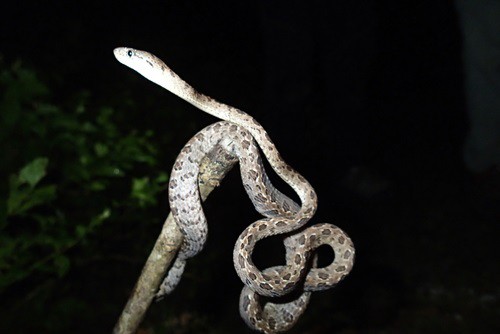
Probably the second most abundant Boiga catsnake in Thailand. This species also covers Cambodia, Vietnam, Myanmar, and is especially common in Hong Kong. Like the green catsnake, their range fizzles out in Bangladesh and far northeast India.
This ticks most of the boxes for a Boiga catsnake: sharply vertical pupils, a branch-dwelling lifstyle, and a mild venom which has never killed a human on record. The many-spotted catsnake averages at 70cm, yet certain individuals can break far beyond this to reach 187cm. They lay 4-8 eggs and feed on lizards and birds. Their personality is a two-sided coin. Firstly, they’re calm and take much provocation to enter aggressive mode. But when they do, they readily strike and snap at intruders until they back off in fear. Many-spotted catsnakes are reasonably flexible, appearing in forests, woodlands, gardens, bamboo groves and cultivated areas. The one rule is that they always require trees.
In 2023, this species gained even more territory. The tawny catsnake (Boiga ochracea) was subjected to genetic analysis and found to have low differentiation to many-spotted catsnakes. The two were combined, and Boiga multomaculata extended its empire north-westwards into Bangladesh. Boiga ochracea ceased to exist overnight, at the scribbling of a scientist’s pen.
